1. Introduction
Library is always a symbol of the university. It provides college students with many useful resources. At the same time, how to make full of the resources becomes a new problem for college students. For that purpose, the present survey is made.
1.1 Purpose
The survey sets its goal at investigating how well the college students can take advantage of the resources provided in our school library. Then, we hope to give some suggestions to our school library so that it can be improved in some aspects.
1.2 Subjects
In order to make the survey more persuasive, we did the research among students in our university including both undergraduates and postgraduates. 157 copies of questionnaires in total were handed out and 150 were collected back which are effective. Interviewees are from different majors and different grades. 41 of them are freshmen, 42 are sophomore, 21 are junior students, 30 are senior students and 6 are postgraduates.
1.3 Time and Place
Time: The survey takes about one week, from November 10th to November 16th, 2008. The questionnaires were distributed on November 10th and collected back on November 11th.
Place: Hebei Polytechnic University
1.4 Instrument
Questionnaires are used to collect data. Considering the questionnaire in English may bring some trouble to the interviewees with different English levels, we adopt the Chinese version instead of the English one (See English and Chinese versions in appendices).
The interviewees are selected at random to make the data more reliable. For instance, the questionnaires are given to the students studying in classrooms and to those staying in dormitories. What’s more, students from all grades are made sure to participate in this investigation.
2. Data Collection and Analysis
On 10th November, we investigated 157 students, among whom 150 returned their questionnaires. The rest did not return or finish for some reasons.
To ensure the validity of the survey, the six members in our team were divided into three groups to hand out the questionnaires, going to different places and investigating different students. Most of the interviewees were willingly to help us with the survey. They finished the questionnaires carefully. Among the questionnaires returned, some questions were not answered, and some were answered casually, which brought us some trouble when we did the data collection.
In general, most of the information we collected was useful and accurate.
2.1 Data Analysis on the Use of Books
The analysis on the use of books is based on Question 2, 4, 5, 6, 7, 8, 9 and 10.
2.1.1Frequency Analysis
According to Question 2 and 4, we get a result as follows (see Figure 1).
Figure 1
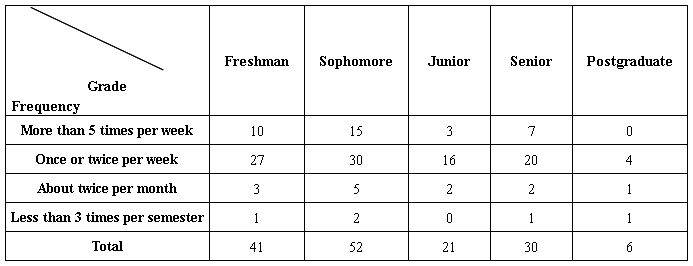
Result:
As it can be seen from Figure 1, most students go to library once or twice a week. Some students go there more than five times a week. The freshmen and junior students go to the library more frequently.
Reasons:
1) The freshmen have more spare time and they are curious about the library where they can find almost all the books and periodicals they are interested in.
2) The junior students need a lot of materials for their courses. Moreover, most of the juniors want to find some quiet places to study and the library becomes their first choice.
2.1.2 Purpose Analysis
Question 5 is designed to know the college students’ purposes of going to the school library.
Figure 2
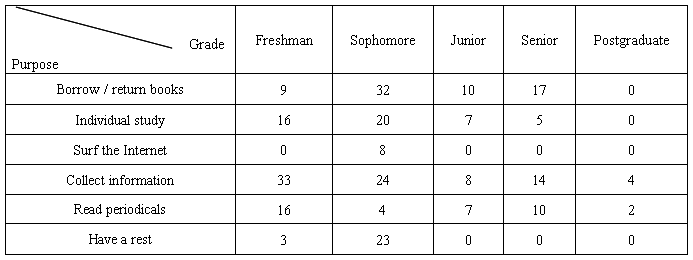
Figure3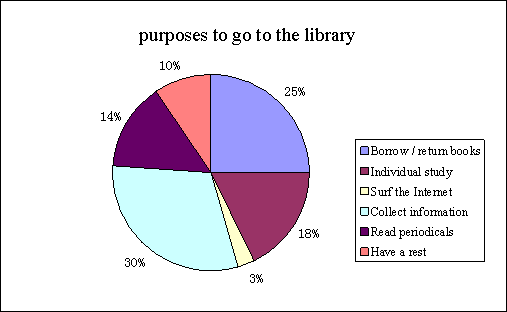
Result:
Figure 2 and 3 reveal that the sophomores and the junior students can make full use of the resources in the library. Their purposes are clear: they hope to improve themselves on all aspects. While the freshmen have less pressure, so they prefer the periodicals just for entertaining and widening their horizon. The seniors and postgraduates like to read periodicals because they want to help with homework or essay writing and know more about current affairs.
2.1.3Book Variety Analysis
Based on Question 9, we get Figure 4 below.
Figure 4
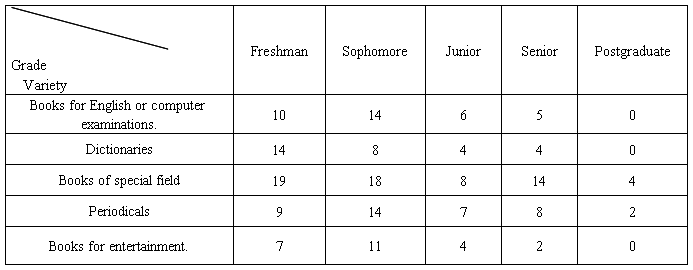
Result:
Obviously, most of the interviewees think that books of special field are most helpful. It shows that most of students in our university put study in the first place. We can also learn that other kinds of books and magazines are also very useful in most students’ eyes. However, 76.67% of the students investigated are dissatisfied with the books in our library. They complain that the books are outdated and they need to be updated.
2.1.4On Borrowing Books
According to the statistics based on Question 7 and 8, we learn that 41.33% of the students borrow less than 10 books in one semester while 7.33% borrow more than 30. 70% say that they can finish reading most parts of the borrowed books before returning them. This is a good phenomenon. Since different people have different plans for study, sometimes they don’t need to finish the whole. Instead, some parts of books are enough.
2.1.5On Facilities and Reading Rooms
In consequence of Question 6, it is known that students like to go to the natural science and social science reading room, besides periodicals and newspapers reading room. The most popular section is periodicals reading section. Students can not only expand their knowledge but also know something about arts, sports and so on. As well, they can release from the pressure in daily study.
According to our survey (Question 10), 30.67% of students can use all the functions of the data retrieval system skillfully, 42% of them are likely to use only some of the functions, while there are 27.33% who seldom use it. A research, once carried out by the former State Education Commission on students studying aboard, found that Chinese students’ low level of scientific research stemmed from their ability of referring and using information materials (especially the ability to use the data retrieval system of combined computers) (Gao & Li, 1998; Yan & Luo, 2003). So it’s very necessary to improve our ability to refer to information. We suggest college students, especially freshmen, should learn to use the data retrieval system as soon as possible.
2.2 Data Analysis on the Use of Periodicals and Newspapers
Question 12, 13, 14, 15, 16 and 17 are designed to know the general information of periodicals and newspapers section.
2.2.1 Frequency and Purpose Analysis
Figure 5 shows how often the respondents read periodicals and newspapers.
Figure 5
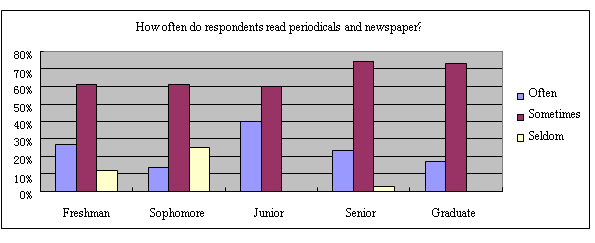 Result:
Result:
Figure 5 demonstrates that from freshmen to graduates, most of them read periodicals and newspapers regularly about 2 or 3 times per week. Only a few freshmen and sophomores never or seldom read periodicals and newspapers.
The cylindrical Figure 6 below tells us the purposes for respondents to read periodicals and newspapers.
Figure 6
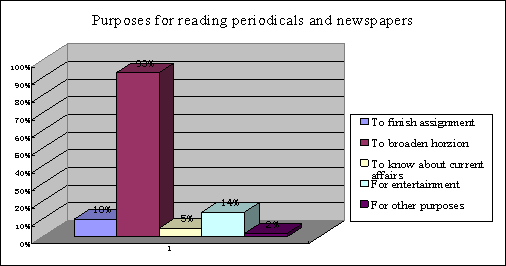
Result:
It shows that the purpose for finishing assignment takes 10%, for broadening horizon takes 93%, and for entertainment takes 14%. It is obvious that broadening horizon is the main purpose for students to go to the forth floor to read periodicals and newspapers, because school library is the most important place to acquire knowledge and collect information. However, what attracts our attention is entertainment occupies the second place for students to use advanced equipment in the library.
Reasons:
From Figure 5 and 6 above:
1) The library’s opening time conflicts with student’s class time. And college students in our campus can’t balance their time well, so the chances for students to enter the library are limited.
2) Students can’t borrow the periodicals and newspaper from the school library.
3) There is little recourse about science, humanity, literature in college student’s hands. They have no other choices.
4) Freshmen who have less lectures and more spare time, and seniors who are under great pressure prefer to read some periodicals and newspaper for entertainment.
2.2.2 On the Outdated Periodicals and Newspapers
The following two figures show the use of periodicals and newspapers in our library
Figure 7

Figure 8
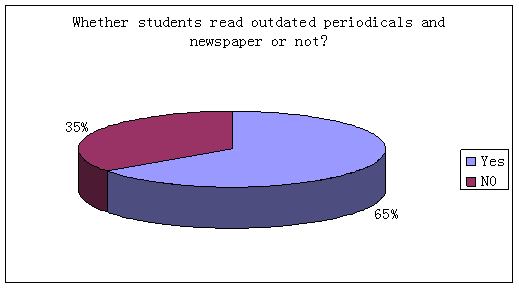
Result:
Figure 7 obviously shows that 71% respondents take notes when they read periodicals and newspapers. It is nearly 2 times of the respondents who don’t take notes while reading. Figure 8 shows that 65% of the students who take part in our investigation have the experience of reading the outdated periodicals and newspapers. While 35% of them never read any outdated periodicals or newspapers.
Reasons:
1) Due to the fact that the periodicals and newspapers can only be read in the library, the students who want to collect information or digest some details have to take notes.
2) The students who don’t take notes result from their consideration that taking notes is a waste of time.
3) The reason for most students having the habit of reading outdated periodicals and newspapers is that the number of the latest ones is limited.
4) The students who focus on latest periodicals and newspapers maintain that the outdated ones are worthless.
Suggestions:
1) Extend the opening time. For instance, open the library the whole day from 7:00 a.m~10:00 p.m.
2) Allow the students to borrow the periodicals and newspapers, whatever the outdated or the latest.
3) Introduce more useful and interesting periodicals and newspapers and enlarge the quantities.
2.3 Data Analysis on the Use of Electronic Resources
Questions 18, 19, 20 and 21 provide basis for this analysis.
The electronic resources are an important part in our university library, because of which, it is involved in the investigation.
Figure 9
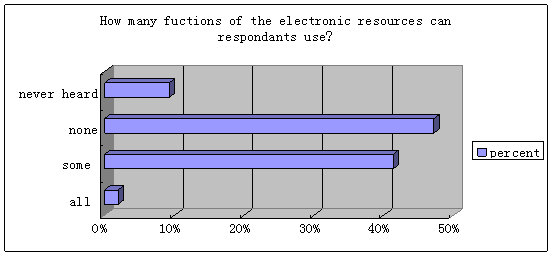
From the above figure, we can know that most of them can just use some of the functions. Most students who are familiar with the electronic resources are senior students and postgraduates. In addition, more than half of the interviewees just heard of it, but never used it.
The majority users converge in senior students and graduate students, while lower grades know little about electronic resources. Their purpose is mainly on searching some information from both China and abroad. In their opinion, the electronic resources are in great value and very helpful for them.
Reasons:
1) Students, especially freshmen, are not so familiar with the electronic resources.
2) The computers are not enough for students to look for information in the electronic resources area.
Suggestions:
1) The library should give some lectures on how to use the electronic resources so that students can be more familiar with it.
2) Increase the number of computers in school library and allow students to use computers in the reading rooms.
2.4 Data Analysis on the Use of Individual-study Area
The analysis, focused on the use of individual-study area, has its base on Question 22 and 23.
According to our survey, 13.3% of the interviewees said that they always go to the library for individual study, while 57.3% sometimes do the individual study. Another 6% have never been there for individual study.
Nearly half of the interviewees think the environment of our school library is just in an average level, while 40% of them consider it good. As for interviewees who want to go further study, they hold the opinion that the environment in individual-study area is not good enough.
From the survey, we can see that most of the respondents are willing to study in individual-study area. However, they are not very satisfied with the environment.
The individual-study area is one of the important hardware facilities. The seats there are not enough and they are always occupied by some students who don’t obey the rules of library. Their action leads to the result that students can’t make the most use of the individual-study area. That’s unfair for those well-disciplined readers. On the other hand, the attitude of the librarians is not good enough. Sometimes they treat students in rude ways.
3. Conclusions
Through the whole survey, we find a good phenomenon that most students in our university have the desire to take advantage of the resources provided in school library, especially the references in their own major. Most students’ purpose to go to the library is to look for the materials that help them in their own field. What’s more, we are glad to find that most people can finish reading the majority of the books they borrowed. In addition, students participated prefer to read periodicals and newspapers so that they can broaden their horizon and enjoy themselves. Most of them are willing to read outdated periodicals and newspapers. From this point, we learn that their craving for knowledge is strong.
However, we still find some problems facing college students, there are three main problems as follows.
First, most students don’t know how to use data retrieval system. As a result, they have to waste a lot of time on looking for a certain book shelf by shelf.
Second,students seldom use the electronic resources. What’s worse, some students, especially undergraduate students, even don’t know there are electronic resources in our school library. As a result, they ignore a huge treasure-house of knowledge and information.
Third, many students complain that the books in school library are outdated and can’t meet their needs. In addition, our school library is lack of some files leading the academic research in some field. Aimed at solving these problems, we give some suggestions in Part 4.
4. Suggestions
1) According to our survey, the interviewees said they did not know well about how to use the electronic resources and information searching program. So the library should give some lectures on how to properly use the data retrieval system so that the students can hold “the key of the treasury-house about knowledge” (Cui, 2004). The librarians can use blackboards and Internet to give the bulletin to students. In addition, they can make some speeches about how to use the equipments in library to help us students master the methods of taking advantage of recourses in the library.
2) Though the library has spent a huge amount of money building four electronic libraries for readers, many students still know little about them due to the lack of dissemination. School library didn’t mention how to take advantage of them. That is a waste of resources and money. The well-used network provides a convenient way to teach and learn, so digital resources will play a more and more important role in our study. That requires us to be conscious of the significance of information and importance of our digital resources.
3) The students should work hard and learn as much as possible during the college life and have initiative to seek more skills and knowledge. We can help each other to know more about how to use the resources in library and share what we have gained from study.
4) The librarians can invite some excellent professional teachers to give some lectures which meet the students’ needs in order to improve our students’ self-study ability.
5) Some of the books stored in library are out of date and the range of them are too limited, so the students who participated in the survey hope that our school library can enrich the book storage, accept the suggestions raised by students, bring in some books which meet the needs of readers, and let our students know that those books are professional, abundant and fashionable. Some popular journals and subscriptions like China Daily, Readers and Times should be presented more.
6) Readjusting and prolonging the opening time, especially on weekends so that students can have enough time to return and borrow books.
7) Finally, the library should prohibit students from occupying seats in studying zone. School library should provide students with more seats in studying zone. Also, “Keep quiet” should be carried out through to the end.
5. Limitations
Our survey is limited in terms of place, which is confined only in our university. It cannot indicate the thorough conditions in all universities. So our analyses are not sweeping enough. In addition, our survey is limited in our polytechnic university. That means, 60% of the respondents are science and engineering students, and only 3.3% of the students are from the college of humanities and law. Therefore, the depth and width of the questions are limited.
Bibliography
[1] 毛峡,丁应宽.图象的情感特征分析及其和谐感评价[J].电子学报,2001,29(12A):1923-1927.
[2] 刘国钧,王连成.图书馆史研究[M].北京:高等教育出版社,1979:15-18,31.
[3] 毛峡.绘画的音乐表现[A].中国人工智能学会20##年全国学术年会论文集[C].北京:北京邮电大学出版社,2001:739-740.
[4] 张和生.地质力学系统理论[A].太原:太原理工大学,1998.
[5] 冯西桥.核反应堆压力容器的LBB分析[R].北京:清华大学核能技术设计研究院,1997.
[6]姜锡洲.一种温热外敷药制备方案[P].中国专利:881056078,1983-08-02.
[7]GB/T16159-1996,汉语拼音正词法基本规则[S].北京:中国标准出版社,1996.
[8]王名亮.中国学术期刊标准化数据库系统工程的[EB/OL]. Http//xxxxx.ndjkfmk.fbuiwa/nsbvhjiaf/ckjv/980810-2.jkncjsans,1998-08-06/1998-10-04.
Acknowledgements
(致谢,约100英文字)
Appendices
Questionnaire in English
Questionnaire in Chinese
A Questionnaire on College Students’ Use of the School Library Resources
Dear friends,
The questionnaire is designed for the purpose of investigating college students’ use of the school library resources. We would appreciate it if you can spare a few minutes to help us finish the survey. Thanks for your cooperation.
1. Your gender?
A. Male B. Female
2. Your grade?
A. Freshman B. Sophomore C. Junior D. Senior E. Postgraduate candidate
3. Which of the following does your major belong to?
A. Science and Engineering B. Economic and Management
C. Humanity and Law D. Foreign Languages E. Arts
4. How often do you go to the library?
A. More than 5 times per week. B. Once or twice per week.
C. About twice per month. D. Less than 3 times per semester. E. Seldom.
5. Why do you go to the library? (You can choose more than one of the following.)
A. Borrow or return books. B. Individual-study. C. Surf the Internet.
D. Collect information. E. Read magazines and periodicals. F. Have a rest.
6. Which reading section do you like best? (You can choose more than one of the following.)
A. 2F: Literature and Arts and History Section
B. 2F: Chinese, Foreign Language and Dictionaries Stack Room
C. 3F: Social and Natural Sciences and Technology Section
D. 4F: Newspapers and Periodicals Reading Area
F. 5F: Foreign Language Reading Room
7. How many books do you borrow from the library every semester?
A. Less than 10 (including 10). B. 11~20. C. 21~30. D. More than 31.
8. How many books (borrowed from the library) can you finish reading?
A. All of them. B. Most of them. C. Some of them. D. Few of them.
9. What books do you think benefit you most?
A. Books for English or computer examinations.
B. Dictionaries.
C. Books of special field.
D. Books for entertainment.
E. Magazines and newspapers.
10. Can you use the data retrieval system well?
A. I can use all the functions skillfully.
B. I can use only some of the functions.
C. I seldom use it.
11. Do you think the resources in school library are enough for your study?
A. Enough B. Not enough, because the resources are out of date.
12. How often do you read periodicals and newspapers?
A. Often B. Sometimes C. Seldom
13. What kind of periodicals or newspapers do you prefer?
A. Natural science. B. Social science. C. Literature.
D. Academic research. E. Entertainment. F. Others.
14. What is your purpose to read periodicals or newspapers? (It is acceptable if you choose more than one of the following.)
A. To help with homework or essay writing. B. To broaden horizon.
C. To get to know current affairs. D. For entertainment.
E. For other purposes.
15. Do you take notes when you read periodicals or newspapers?
A. Yes. B. No.
16. Have you ever read the outdated periodicals or newspaper?
A. Yes. B. No.
17. What kind of periodicals or newspapers do you prefer if they can be borrowed?
A. The outdated. B. The latest. C. Both A and B. D. Neither A or B.
18. Do you know about the electronic resources?
A. I know it well and use it very often. B. I know a little and use a little.
C. I heard about it, but never use it. D. I never heard of it
19. Which kind of electronic resources do you often use? (It is acceptable if you choose more than one of the following.)
A. Periodicals in Chinese.
B. Books in Chinese.
C. Data base in Chinese.
D. Periodicals in foreign languages.
E. Books in foreign languages
F. I never use it.
20. What is your purpose to use the electronic resources?
A. Information collection. B. Information scanning.
C. Academic study D. I never use it.
21. Do you think the electronic resources are helpful?
A. Yes. I benefit a lot. B. Just so so.
C. It can give me a little help. D. I never use it.
22. Do you often go to the library for individual-study?
A. Often. B. Sometimes. C. Seldom. D. Never.
23. How do you think of the environment of the individual-study area?
A. Very good. B. All right. C. Very bad.
24. What are your suggestions for our school library?
大学生对图书馆资源利用情况的调查问卷
亲爱的同学们,为了了解大家对学校图书馆资源的利用和使用情况,我们作了本次调查,希望您能抽出一些宝贵时间配合我们的调查,谢谢您的合作。
1.您的性别?
A.男 B.女
2.您的年级?
A.大一 B.大二 C.大三 D.大四 E.研究生
3.您的专业门类是?
A.理工类 B.经管类 C.文法类 D.外语类 E.艺术类
4.您经常去图书馆吗?
A.一周五次以上 B.一周一两次 C.两三周一次 D.一学期两三次 E.很少
5.您去图书馆的主要目的?(可多选)
A.借、还书 B.自习 C.上网 D.看书、查资料 E.看杂志、期刊 F.睡觉休息
6.您经常去以下哪些阅览室?
A.二层西区语言文字类图书阅览室
B.二层东区文学艺术类图书阅览室
C.三层自然科学与社科类图书阅览室
D.四层期刊杂志与报纸阅览室
E.五层外文资料室
7.现在平均一学期您从图书馆中借阅多少本书?
A.10本以下 B.11~20本 C.21~30本 D.30本以上
8.您在图书馆所借阅图书的阅读情况是:
A.全看 B.看大部分内容 C.看小部分内容 D.没来得及看
9.您觉得哪些图书对您帮助最大?
A.英语、计算机类考试指导 B.工具书 C.专业书 D.休闲娱乐类 E.报纸杂志类
10.您能否熟练使用图书馆的图书检索工具?
A.能熟练使用其全部功能 B.仅能使用其部分功能 C.很少使用检索工具
11.您认为图书馆馆藏资料对于自己的学科学习来说
A.足够 B.不够,资料过于陈旧,缺乏新资料
12.您经常阅读期刊杂志和报纸吗?
A.经常阅读 B.偶尔阅读 C.很少阅读
13.您主要阅读哪类期刊杂志或报纸?
A.自然科学类 B.社会科学类 C.文学类 D.学术研究类 E.娱乐休闲类 F.其他
14.您阅读期刊杂志报纸的目的是?
A.完成作业或论文 B.拓宽知识面 C.了解时政 D.休闲娱乐 E.其他
15.您在阅读期刊杂志和报纸时是否做摘要或笔记?
A.是 B.否
16.您是否会阅读过刊?
A.是 B.否
17.如果图书馆的期刊杂志和报纸可以借出,您希望借阅?
A.过刊 B.现刊 C. 过刊和现刊都想借阅 D.不想借阅,只想在阅览室阅览
18.您对图书馆电子资源的了解程度
A.非常了解,几乎每个数据库都使用过 B.用过一些
C.听说过,但没用过 D.不知道图书馆有电子资源
19.您常使用哪些类型的图书馆电子资源?(可多选)
A.中文期刊类 B.中文图书类 C.中文数据库类 D.外文期刊类 E.外文图书 F.不用
20.您使用图书馆电子资源的目的是?
A.查找资料 B.简单浏览 C.学术研究 D.未使用过
21.您认为电子资源的利用价值如何?
A.很有利用价值,帮助很大 B.利用价值一般,有帮助但不大
C.没有什么利用价值 D.从没用过,不清楚其利用价值
22.您经常去图书馆上自习吗?
A.经常去 B.偶尔去 C.很少去 D.从来不去
23.您认为图书馆自习区的自习环境如何?
A.环境很好 B.环境一般 C.环境很差,很乱
24.您对图书馆有何建议?
